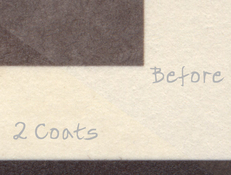nmp
Member
So I got myself some Dorland's Wax Medium while ago and I used it on one of my salts.
Procedure:
Coat #1: Applied wax with gloved fingers. Let sit for a few minutes (around 5,) then took off the excess with a cotton pad. Turns out it wasn't a good idea to let it dry first because it hardened the wax just enough make it flaky. Cotton pad I used did have some fiber shedding too. May not be the best material for this purpose. Then used a hair dryer to warm up the wax in the hopes of healing some of the marks created by the rubbing action and leveling the wax over the contours of the paper. Allowed to dry overnight.
Coat #2: This time used a piece of fabric from an old tee-shirt folded into a pad, picked up some wax and applied it directly over the print and immediately with another pad took the excess off and continued buffing the surface. Much better outcome. Hair dryer and overnight drying as before.
First impressions:
It introduces significant gloss as – more like pearl as the paper texture still plays a role. I would want to back off the glossiness a bit so the reflections do not distract when viewed at an angle too much. May be try both coats next time with the Coat #2 procedure with a little more buffing.
Looking at it straight on – it brings a significant amount of pop to the print – darkening the shadows while keeping the highlights close to where they were – increasing the perceived contrast and the DR on the print. Quantitatively, a spot measurement on the scan in the dark area of the print gave 63 before vs 59 after 1 coat vs 50 for 2 coats (Average RGB values.) That is a significant improvement, I would say. The same in the white border measured 228 vs 229 vs 228 – essentially unchanged.
The edges also seem better defined. The dusty look (my term) of a salt print brought out by fibers of the paper sticking out is replaced with a more cleaner one.
Attachments:
Cycle the first 3 quickly to appreciate the difference:
1. Before applying wax
2. After Coat #1
3. After Coat #2
4. High mag comparison: before vs 1 coat
5. High mag comparison: 1 coat vs 2 coats
6. High mag comparison: before vs 2 coats – white border area






Bottom line:
I like what I see. Recommended if you are looking for some way to add some luster and depth to your salt prints. The process is fairly easy with a pre-made cold wax – no need to mix anything.
:Niranjan.
Procedure:
Coat #1: Applied wax with gloved fingers. Let sit for a few minutes (around 5,) then took off the excess with a cotton pad. Turns out it wasn't a good idea to let it dry first because it hardened the wax just enough make it flaky. Cotton pad I used did have some fiber shedding too. May not be the best material for this purpose. Then used a hair dryer to warm up the wax in the hopes of healing some of the marks created by the rubbing action and leveling the wax over the contours of the paper. Allowed to dry overnight.
Coat #2: This time used a piece of fabric from an old tee-shirt folded into a pad, picked up some wax and applied it directly over the print and immediately with another pad took the excess off and continued buffing the surface. Much better outcome. Hair dryer and overnight drying as before.
First impressions:
It introduces significant gloss as – more like pearl as the paper texture still plays a role. I would want to back off the glossiness a bit so the reflections do not distract when viewed at an angle too much. May be try both coats next time with the Coat #2 procedure with a little more buffing.
Looking at it straight on – it brings a significant amount of pop to the print – darkening the shadows while keeping the highlights close to where they were – increasing the perceived contrast and the DR on the print. Quantitatively, a spot measurement on the scan in the dark area of the print gave 63 before vs 59 after 1 coat vs 50 for 2 coats (Average RGB values.) That is a significant improvement, I would say. The same in the white border measured 228 vs 229 vs 228 – essentially unchanged.
The edges also seem better defined. The dusty look (my term) of a salt print brought out by fibers of the paper sticking out is replaced with a more cleaner one.
Attachments:
Cycle the first 3 quickly to appreciate the difference:
1. Before applying wax
2. After Coat #1
3. After Coat #2
4. High mag comparison: before vs 1 coat
5. High mag comparison: 1 coat vs 2 coats
6. High mag comparison: before vs 2 coats – white border area






Bottom line:
I like what I see. Recommended if you are looking for some way to add some luster and depth to your salt prints. The process is fairly easy with a pre-made cold wax – no need to mix anything.
:Niranjan.












